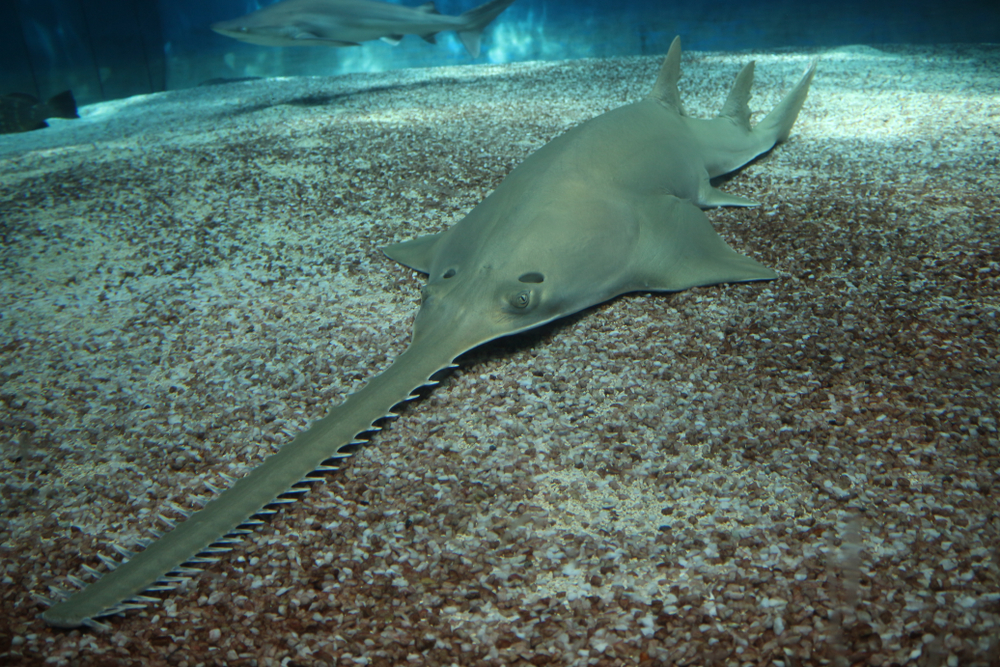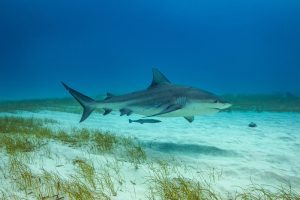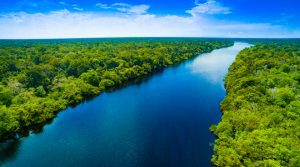In the shark world, freshwater species are a rarity. On the entire planet, there are only a few species of freshwater shark.
Freshwater settings like lakes and rivers are home to these unusual creatures.
Given the lack of salinity in freshwater, it is extremely difficult for sharks that have developed in saltwater to adapt to freshwater.
However, there are two kinds of sharks that can survive in freshwater for a lengthy period because of their physiological adaptations.
Bull sharks have been seen in the Mississippi and Amazon rivers thousands of miles away from the ocean, as well as the Bizant River shark, which is sometimes seen in Australian rivers hundreds of miles from the sea.
Other sharks that can juggle fresh and saltwater are the Borneo River shark, Ganges shark, and speartooth shark.
Other sharks can survive for a short period, but those two sharks practically live in freshwater.
These freshwater shark species are discussed as well as how to tell them apart.
Table of Contents
Which Species of Shark Can Live in Fresh Water?

Both the bull and Bizant River sharks have been caught in rivers thousands of miles from the ocean, including the Amazon River and Mississippi River, where they were caught.
Although these sharks can remain in freshwater for a long time, they are not common in rivers or lakes.
Most shark cells can burst and cause bloating and death if salt is not retained in the body. As a result, many seawater species of sharks sink to the bottom of freshwater lakes.
The ability of some species to store salt as well as recycle it inside their bodies means that freshwater sharks are now present in rivers and lakes across the globe due to their salt-retaining nature.
Even though certain sharks can live in freshwater estuaries and even use them as a nursery for their young, they spend most of their time in the salty ocean.
Sharks, such as the bull and Bizant, can, however, survive in freshwater for lengthy periods due to physiological changes that allow this.
Largest Freshwater Fish in the World
The largest freshwater fish is the sturgeon. There is no freshwater fish in the world larger than a beluga sturgeon in Russia.

The biggest North American freshwater fish is the white sturgeon.
This species of sturgeon is known for its size and weight, which can reach up to 15 feet in length.
Among North American freshwater fish, the alligator gar is the second-largest.
Most Common Sharks Seen in Freshwater
The Speartooth Shark
In the murky waters of a freshwater lake, you may come across a mature speartooth shark. This particular species of shark, the Glyphis, is capable of swimming in both seawater and freshwater environments.
This very uncommon species of freshwater shark can only be found in the tropical riverbeds and fast-flowing estuaries of northern Australia, Papua New Guinea, and West Papua.
To conserve energy when feeding on fish and invertebrates, the speartooth shark utilizes ocean tides to move them upstream.
This hardy species of shark, which can reach lengths of 9.8 feet, has a large head, a flattened snout, and small eyes.

In both the upper and lower jaws, they have around 29 rows of teeth. The upper teeth of the speartooth shark are large and serrated, but the lower teeth are tiny and spear-shaped, which is why this freshwater shark is known as a speartooth shark.
The Ganges Shark
The more hazardous bull shark is frequently mistaken for the Ganges shark. One of the most endangered shark species in the world, the Ganges shark lives in the Brahmaputra, Mahanadi, Hooghly, and Ganga rivers of India.
This kind of shark is known as a river shark since it can only be found in freshwater environments. Solid grey or brown coloration distinguishes the Ganges shark.
Because of their habitat’s poor visibility, they have relatively small eyes, plus their two spineless frontal fins as well as a broad, spherical snout help to identify them.
These freshwater sharks are commonly confused with the ferocious bull shark, which the general public perceives as a danger to human life.
Because Ganges sharks are extremely rare and their teeth are specially built to pierce fish rather than mammals, they are unlikely to attack humans.

The Bull Shark
Shark attacks on people by Carcharhinus Leucas, the bull shark, have been reported. Both saltwater and freshwater bull sharks are found around the world.
As one of the few shark species that can flourish in either fresh or saltwater habitats, it is one of the most distinctive sorts of sharks on the planet.
It’s not uncommon to see this sort of freshwater shark lurking in places where people assume there’s no risk.
However, the bull shark is one of the most frequent freshwater sharks in lakes because of its capacity to swim thousands of kilometers upriver.
It is not uncommon for them to mistake swimmers for food in shallow waters, where humans are more prone to go.
Due to its lack of distinctive characteristics, it can be fairly difficult to distinguish a bull shark from other species of shark.
So, they are often mistaken for the Great White shark and the Ganges River shark. In contrast to many other freshwater shark species, the bull shark is one of the best for aquariums and can live for many years in captivity!
Sharks from the Borneo River

The Borneo River shark is known as the “mythical shark” due to its rarity. The Borneo River shark, another of the world’s rarest freshwater shark species, may be found in the Kinabatangan River.
Requiem or Carcharhinidae sharks (which Borneo River sharks are descended from) are found primarily in warm tropical waters.
The overall length of this specific freshwater species is just 2 feet.
The darkening of the dorsal fins’ slate-gray coloring aids in their recognition. The Borneo River shark prefers to eat bony fish like sardines and tuna because of its serrated teeth.
What Percentage of Sharks are Freshwater?
The majority of sharks can’t live in freshwater, despite their reputation as vicious predators. Only 5% of elasmobranchs (skates, rays, and sharks) can live in freshwater, which includes goldfish and rainbow trout.
A lack of fresh water impairs the ability of these animals to reproduce as well as dries and dulls their senses.
In contrast to modern fish, the ancient elasmobranchs relied only on their oily livers for floating.

How Do Sharks Adapt to Freshwater?
Researchers hypothesized that freshwater species could compensate by gaining weight through the storing of fat in their livers.
However, they also noted that this would reduce their hunting efficiency compared to species that live in the sea.
According to new data from the Fitzroy River in Washington, two freshwater elasmobranchs have confirmed the estimates.
As a result of their extra-fatty livers, bull sharks and large-tooth sawfish were found to be less buoyant than 27 other previously studied ocean species.
More studies are needed to assess if freshwater sharks were formerly more widespread, or if buoyancy issues or other variables eventually drove sharks into the ocean.
Where in Nicaragua Has Many Freshwater Sharks?
Lake Nicaragua, Central America’s largest, is a sight to behold. The “sweet sea” refers to a body of water in Nicaragua that encompasses an area of more than 8,000 square kilometers.

It’s a fitting name for a lake that looks and feels a lot like the ocean, right down to the waves, islands, and sharks.
Even though Lake Nicaragua is a freshwater lake, it is home to sharks that have evolved to live in freshwater.
The lake’s closeness to the Pacific Ocean led geologists to conclude that the region it now covers was once a vast harbor.
How Did So Many Sharks End Up in a Nicaraguan Lake?
The sharks’ presence was attributed to the gap closing over time, confining them, and causing them to adapt to the freshwater that replaced the saltwater.
Recent studies, on the other hand, suggest that the sharks may have gone up the San Juan River, which links the lake with the Caribbean Sea, by leaping upstream like salmon.
Because of their stocky build, wide flat snouts, and generally unpredictable and aggressive temperament, bull sharks have been mistaken for a separate species by scientists who felt they were unique.
In addition to being known as the Nicaragua shark in Nicaragua, this shark is also called Zambia or Zambezi shark in Africa as well as the Ganges or Sundarbans shark in India, among other names.
Where Do Bull Sharks Prefer to Swim?

In contrast to so many coastal sharks, bull sharks can survive and thrive in freshwater. Warm, shallow waters in rivers and around the coasts are preferred by bull sharks.
Bull sharks are considered one of the deadliest kinds of sharks from a human perspective, and it is widely thought that they are responsible for the bulk of attacks on humans in shallow water.
Environmentalists believe that for any lake or sea, human beings should start treating the non-human occupants of the area with respect and recognize their entitlement to be there.
They claim that just because the Nicaragua shark is a dangerous predator, it does not detract from Lake Nicaragua’s natural beauty in any way.
How Many Different Types of Sharks Exist?
Sharks have survived dinosaurs and several other species of life on Earth by 400 million years, according to fossilized remains.
Sharks, as well as rays, number more than 1,000 different species, and more are found each year.
It is now more than ever that these spectacular top predators, which are so vital to ocean life, meet their greatest threat from overfishing.
Sawfishes, a family of rays, are among the many species at risk of extinction.

This fine line is in peril of being disrupted, as sharks, as well as rays, have long been an indispensable resource for coastal populations throughout the developing world.
How Can Sharks Help Prevent Climate Change?
Increasing the resilience of our oceans to climate change requires the restoration of sharks. Sharks are a diverse group of animals, but their declining numbers due to overfishing and the growing demand for their fins and flesh make conservation efforts even more urgent.
Humans are working to re-establish a healthy relationship between sharks and humans by implementing a variety of initiatives guided by the 10-year Global Priorities for Conservation of Sharks and Rays, a strategy that ends in the year 2025.

















